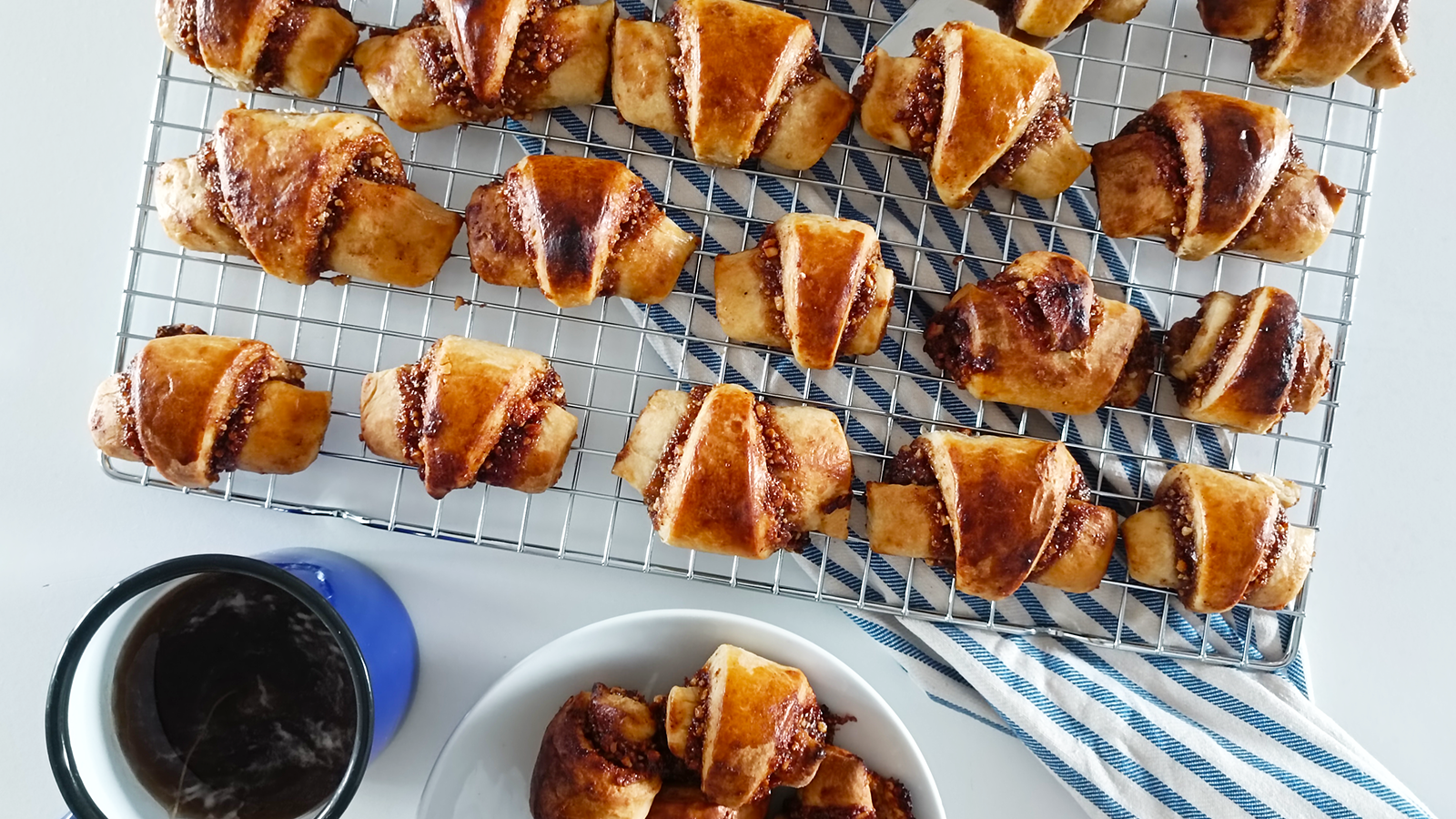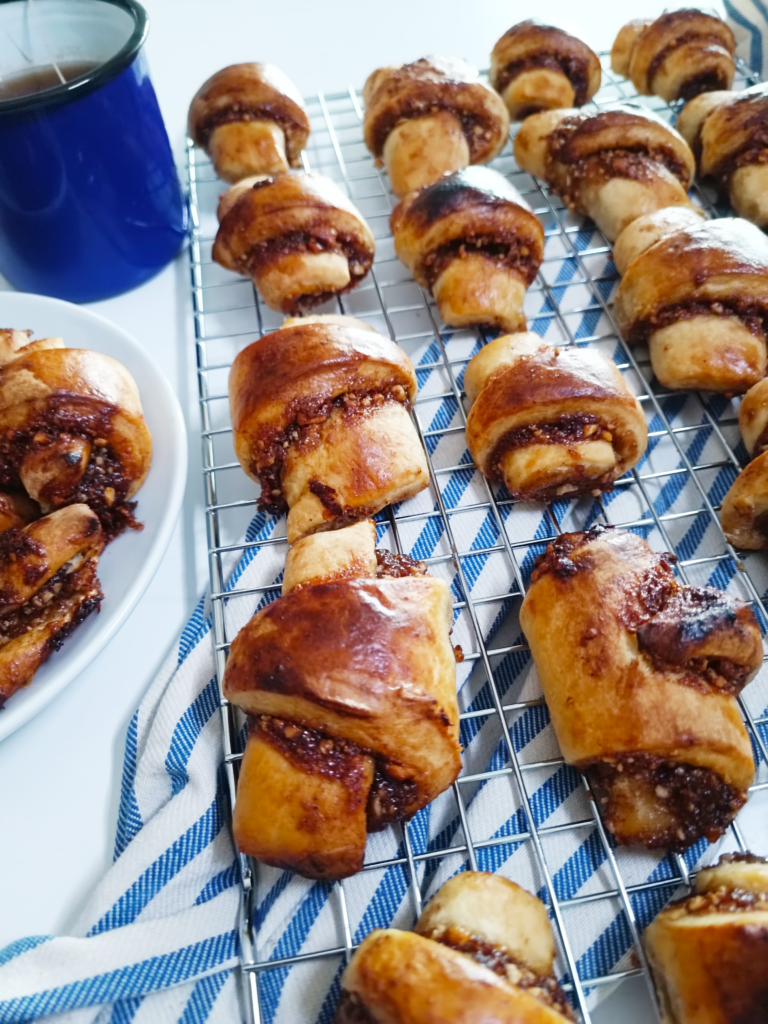Guava rugelach are an edible testament to Jews embracing the new ingredients and cooking techniques that they encountered in the Diaspora. They are also a testament to my mom, a culinary magician who wielded guava like a wand, infusing its sweet tones into our meals.
Brought to Latin America by Eastern European Jews in the early 20th century, cities such as Buenos Aires, Mexico City and Caracas have embraced rugelach. While many versions of the pastry still proudly bear the traditional Ashkenazi flavors of cinnamon, raisins and nuts, that’s far from the whole tale. Rugelach in Buenos Aires or Caracas might contain dulce de leche or cabello de ángel (pumpkin jam), while a stroll into a bakery in Mexico City might reveal rugelach filled with luscious chocolate ganache and aromatic Mexican vanilla.
This rugelach dough is enriched with sour cream, and results in a soft, flakey pastry. The pièce de résistance, though, is the guava filling.
Originating from Central and South America, “guava” translates to “fruit” in Arawak, the language spoken by the native communities of the Caribbean, where this fruit, similar in size to a passion fruit, grows in abundance. The guava’s tender skin encases a creamy white or orange pulp filled with numerous tiny black seeds.
The Nosher celebrates the traditions and recipes that have brought Jews together for centuries. Donate today to keep The Nosher's stories and recipes accessible to all.
As guava is a seasonal fruit and isn’t as widespread as mangoes or papaya, I call for guava paste, due to its unique sour-sweet taste profile. Often referred to as “goiabada,” this paste generally has a lower quotient of added sugars and presents a superior texture for baked products. Unlike runny jams and marmalades, guava paste is sculpted into a dense, sticky block yet remains soft enough to be sliced.
Growing up, my mom used the vibrant, naturally sweet guava as her secret ingredient, a touch of the tropics that hinted at Caribbean culinary tradition in Venezuela. It turned the simplest family recipe into an exotic treat. This recipe draws inspiration from her traditional guava bread, where history, heritage and affection were kneaded into dough and baked to perfection.
Her guava-infused creations echo loudly in my present, shaping the culinary adventurer in me and reminding me of the vital link between taste and memory. Guava rugelach are not merely a pastry but a narrative of the age-old Jewish practice of reinventing ourselves in the face of new environments. The story of my lineage in the Diaspora, one many fellow Jews can relate to, is etched in the buttery dough and sweet, aromatic filling. Each bite is a reminder of who I am: A fusion of cultures, histories and flavors.
These Guava Rugelach Taste Like Home
This recipe for guava rugelach is inspired by Jewish communities in Latin America, who transformed traditional dishes through local ingredients. The dough is enriched with sour cream, and results in a soft, flakey pastry, but pièce de résistance is the guava filling.
- Total Time: 2 hours
- Yield: 24
Ingredients
For the dough:
- 2 cups sour cream
- 2 tsp active dry yeast
- 4 cups all-purpose flour, plus more for dusting
- ¼ cup granulated brown sugar
- 2 egg yolks
- 1 stick (8 Tbsp) unsalted butter, at room temperature
- ½ tsp kosher salt
For the filling:
- 1 cup guava paste, chopped in medium-sized dice
- ½ cup water
- ⅓ cup honey
- 3 tsp ground cinnamon
- ½ cup chopped cashews
- zest of a small lime
For the egg wash:
- 1 large egg
- 1 Tbsp water
Instructions
- Make the dough: Combine the sour cream and yeast in the bowl of a stand mixer fitted with the dough hook attachment, or mix it by hand.
- Add the flour, sugar, egg yolks, butter and salt, and mix on low speed for about 5 minutes or until the ingredients come together. Knead the dough by hand on a lightly floured surface for about 3 minutes until the dough is a smooth, soft ball. Divide the dough into two balls. Wrap each ball loosely in plastic and chill in the refrigerator for at least 1 hour or overnight.
- To make the guava filling: Place the guava paste and ½ cup of water in a saucepan over medium heat. Add honey, cinnamon and lime zest until it liquefies and the chunks of guava paste dissolve into a smooth jam. Set aside the warmed jam and let it cool to room temperature before it can be spread on the rolled-out dough, or else the butter and sour cream in the dough will soften to make the rolling-up step challenging. Once chilled, stir in the ½ cup of chopped cashews.
- When ready to bake, position a rack in the middle of the oven and preheat to 350°F.
- To assemble: Prepare a board for rolling out dough by flouring it generously. Roll out each chilled ball with a rolling pin into a 10-inch circle. Work with one half at a time, keeping the other one chilled in the refrigerator. Once the disk is rolled-out, wrap it in plastic and rest in the fridge for another 20 minutes. Repeat this process one more time with the other ball.
- Place the refrigerated dough onto a lightly floured surface and evenly spread the jam to the edges. Using a pizza wheel or a baking scraper, cut the dough into 12 triangles. Starting with the wider base, roll up each wedge tightly and place it on a lined or silicone baking sheet.
- Make the egg wash: In a small bowl, whisk the egg and water, then brush the cookies with it.
- Bake for 25-30 minutes or until the rugelach are nicely browned.
Notes
- The dough needs to rest for at least 1 hour or overnight.
- The cookies can be kept tightly wrapped (refrigerated or not) in an airtight container for 4-5 days, or frozen for up to 4 months.
- Guava paste should be stored in a dry cupboard or pantry and never in the refrigerator.
- Prep Time: 15 minutes + 1 hour 20 minutes resting
- Cook Time: 25 minutes
- Method: Baking
- Cuisine: Ashkenazi





As a fan of traditional rugelach, I was intrigued and even skeptical by this recipe’s twist with guava.
Never tried this fruit before in a pastry and I gotta say, the result was absolutely delicious! The guava paste adds a unique flavor that perfectly complements the rich buttery dough with the sour. LOVE making rugelach with new fillings.
I can’t WAIT to try these. I also love guava, and have been using guava paste in my hamantaschen for years. Lovely texture and amazing flavor.
Made these for this year’s chanukah and everyone who tried them absolutely fell in LOVE with this recipe. I got so many compliments, I’d say my only regret is that I only did one batch and they were gone immediately and couldn’t froze any 🙁 Publish more recipes like these pleaseeeeee
So glad to hear they were a hit!